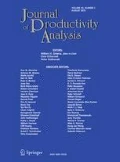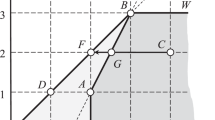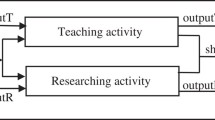Abstract
In a production technology, the type of returns to scale (RTS) associated with an efficient decision making unit (DMU) is indicative of the direction of marginal rescaling that the DMU should undertake in order to improve its productivity. In this paper a concept of global returns to scale (GRS) is developed as an indicator of the direction in which the most productive scale size (MPSS) of an efficient DMU is achieved. The GRS classes are useful in assisting strategic decisions like those involving mergers of units or splitting into smaller firms. The two characterisations, RTS and GRS, are the same in a convex technology but generally different in a non-convex one. It is shown that, in a non-convex technology, the well-known method of testing RTS proposed by Färe et al. is in fact testing for GRS and not RTS. Further, while there are three types of RTS: constant, decreasing and increasing (CRS, DRS and IRS, respectively), the classification according to GRS includes the fourth type of sub-constant GRS, which describes a DMU able to achieve its MPSS by both reducing and increasing the scale of operations. The notion of GRS is applicable to a wide range of technologies, including the free disposal hull (FDH) and all polyhedral technologies used in data envelopment analysis (DEA).
Similar content being viewed by others
References
Agrell, P. J., P. Bogetoft, M. Brock and J. Tind. (2002). “Efficiency Evaluation with Convex Pairs.” KVL, Copenhagen (mimeo).
Ali, A. I. and L. M. Seiford. (1993). “The Mathematical Programming Approach to Efficiency Analysis.” In H. O. Fried, C. A. K. Lovell, and S. S. Schmidt (eds.), The Measurement of Productive Efficiency. Oxford: Oxford University Press, 120–159.
Banker, R. D. (1984). “Estimating Most Productive Scale Size Using Data Envelopment Analysis.” European Journal of Operational Research 17, 35–44.
Banker, R. D., H. Chang and W. W. Cooper. (1996). “Equivalence and Implementation of Alternative Methods for Determining Returns to Scale in Data Envelopment Analysis.” European Journal of Operational Research 89, 473–481.
Banker, R. D., A. Charnes and W. W. Cooper. (1984). “Some Models for Estimating Technical and Scale Inefficiencies in Data Envelopment Analysis.” Management Science 30, 1078–1092.
Banker, R. D., W. W. Cooper, L. M. Seiford, R. M. Thrall and J. Zhu. (2004). “Returns to Scale in Different DEA Models.” European Journal of Operational Research 154, 345–362.
Baumol, W. J., J. C. Panzar and R. D. Willig. (1982). Contestable Markets and the Theory of Industry Structure. New York: Harcourt Brace Jovanovich, Inc.
Bogetoft, P. (1996). “DEA on Relaxed Convexity Assumptions.” Management Science 42, 457–465.
Bogetoft, P., J. M. Tama and J. Tind. (2000). “Convex Input and Output Projections of Nonconvex Production Possibility Sets.” Management Science 46, 858–869.
Briec, W., K. Kerstens, H. Leleu and P. Vanden Eeckaut. (2000). “Returns to Scale on Nonparametric Deterministic Technologies: Simplifying Goodness-of-fit Methods Using Operations on Technologies.” Journal of Productivity Analysis 14, 267–274.
Charnes, A., W. W. Cooper and E. Rhodes. (1978). “Measuring the Efficiency of Decision Making Units.” European Journal of Operational Research 2, 429–444.
Cooper, W. W., L. M. Seiford and K. Tone. (2000). Data Envelopment Analysis. Dordrecht: Kluwer Academic Publishers.
Courant, R. (1967). Differential and Integral Calculus. Volume II, London: Blackie and Son Ltd.
Dekker, D. and T. Post. (2001). “A Quasi-concave DEA Model with an Application for Branch Performance Evaluation.” European Journal of Operational Research 132, 296–311.
Deprins, D., L. Simar and H. Tulkens. (1984). “Measuring Labor-efficiency in Post Offices.” In M. Marchand, P. Pestieau, and H. Tulkens (eds.), The Performance of Public Enterprises. Amsterdam: Elsevier Science Publishers, pp. 243–267.
Färe, R., S. Grosskopf and C. A. K. Lovell. (1983). “The Structure of Technical Efficiency.” Scandinavian Journal of Economics 85, 181–190.
Färe, R., S. Grosskopf and C. A. K. Lovell. (1985). The Measurement of Efficiency of Production. Boston: Kluwer Academic Publishers.
Färe, R., S. Grosskopf and C. A. K. Lovell. (1994). Production Frontiers. Cambridge: Cambridge University Press.
Kerstens, K. and P. Vanden Eeckaut. (1999). “Estimating Returns to Scale Using Non-parametric Deterministic Technologies: A New Method Based on Goodness-of-fit.” European Journal of Operational Research 113, 206–214.
Kuosmanen, T. (2001). “DEA with Efficiency Classification Preserving Conditional Convexity.” European Journal of Operational Research 132, 326–342.
Kuosmanen, T. (2003). “Duality Theory and Non-convex Technologies.” Journal of Productivity Analysis 20, 273–304.
Panzar, J. C. and R. D. Willig. (1977). “Economies of Scale in Multi-output Production.” Quarterly Journal of Economics 91, 481–491.
Petersen, N. C. (1990). “Data Envelopment Analysis on a Relaxed Set of Assumptions.” Management Science 36, 305–314.
Podinovski, V. V. (2002). “Global Scale Characteristics in DEA.” Warwick Business School Research Paper No. 353, University of Warwick, UK.
Podinovski, V. V. (2004a). “On the Linearisation of Reference Technologies for Testing Returns to Scale in FDH Models.” European Journal of Operational Research 152, 800–802.
Podinovski, V. V. (2004b). “Local and Global Returns to Scale in Performance Measurement.” Journal of the Operational Research Society 55, 170–178.
Podinovski, V. V. (2005). “Selective Convexity in DEA Models.” Forthcoming in the European Journal of Operational Research.
Rockafellar, R. T. (1970) Convex Analysis. Princeton, NJ: Princeton University Press.
Seiford, L. M. and J. Zhu. (1999). “An Investigation of Returns to Scale in Data Envelopment Analysis.” Omega 27, 1–11.
Thanassoulis, E. (2001). Introduction to the Theory and Application of Data Envelopment Analysis. Dordrecht: Kluwer Academic Publishers.
Author information
Authors and Affiliations
Rights and permissions
About this article
Cite this article
Podinovski, V. Efficiency and Global Scale Characteristics on the “No Free Lunch” Assumption Only. Journal of Productivity Analysis 22, 227–257 (2004). https://doi.org/10.1007/s11123-004-7575-z
Issue Date:
DOI: https://doi.org/10.1007/s11123-004-7575-z




